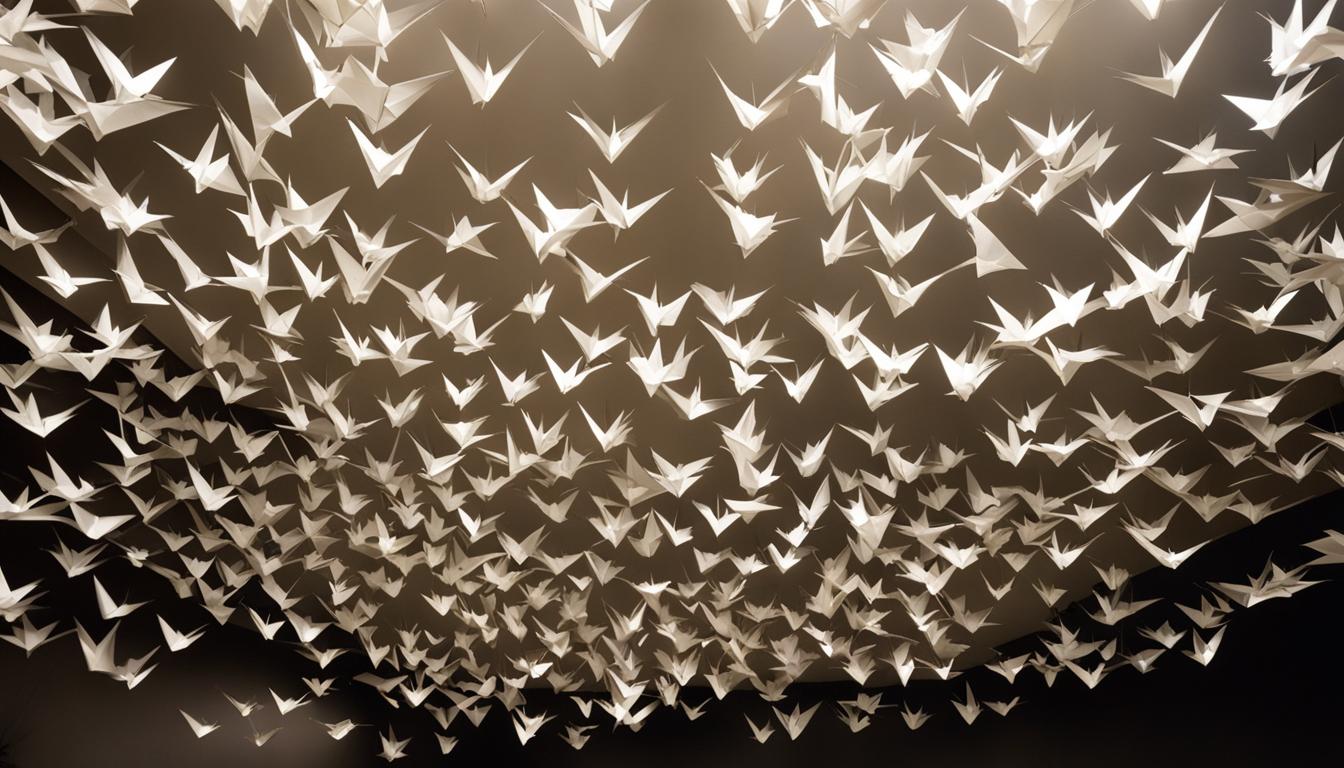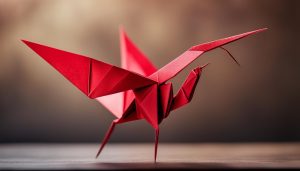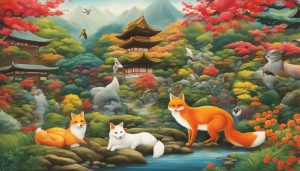Have you ever wondered if folding a thousand white crane origami figures could bring you good luck? The tradition of making origami cranes has a deep history in Japan, where the crane is seen as a symbol of good fortune and longevity. It is believed that making a thousand origami cranes, known as senbazuru, can bring luck and even grant wishes. This practice gained popularity through the inspiring story of Sadako Sasaki, a young girl who folded one thousand paper cranes while battling leukemia in the aftermath of the Hiroshima atomic bomb. Today, the origami crane has become a powerful symbol of hope and peace.
Contents
- 1 The History and Significance of Origami in Japan
- 2 The Story of Sadako Sasaki and 1,000 Paper Cranes
- 3 The Symbolism and Meaning of the Origami Crane
- 4 The Spread of Origami and the Crane Symbolism
- 5 Origami Cranes as a Symbol of Peace in Hiroshima
- 6 Conclusion
- 7 FAQ
- 7.1 Will making a thousand white crane origami figures bring you good luck?
- 7.2 What is the history and significance of origami in Japan?
- 7.3 Can you tell me the story of Sadako Sasaki and 1,000 paper cranes?
- 7.4 What is the symbolism and meaning of the origami crane?
- 7.5 How has the spread of origami and crane symbolism occurred?
- 7.6 What is the significance of origami cranes in Hiroshima?
- 7.7 Is folding origami cranes for good luck and fortune a common practice?
- 7.8 What is the conclusion about origami cranes and their symbolism?
- 8 Source Links
Key Takeaways:
- Making a thousand origami cranes, known as senbazuru, is believed to bring good luck and grant wishes.
- The crane is a symbol of good fortune, longevity, and protection in Japanese culture.
- Sadako Sasaki’s story popularized the tradition of folding origami cranes for hope and healing.
- The origami crane is a universal symbol of peace and a reminder of unity and understanding.
- Folding origami cranes requires patience, dedication, and a belief in the power of positive intentions.
The History and Significance of Origami in Japan
Origami, the art of paper folding, has a rich history in Japan that dates back to the 6th century. Originally known as orikata, origami evolved into an art form and popular leisure activity during the Edo Period. The significance of origami extends beyond its creative expression, with the crane holding a particular importance in Japanese culture. The crane symbolizes good fortune, longevity, and protection, making it a cherished symbol in various aspects of Japanese life.
In feudal Japan, the tradition of folding origami cranes emerged as a practice of honor and loyalty. These delicate paper birds were exchanged as symbols of good wishes and represented the respect between samurai warriors. The crane’s association with longevity and protection further elevated its significance, with the belief that the wings of the crane provided heavenly protection to loved ones.
The first known book on origami, “Hiden Senbazuru Orikata,” was published in Japan in 1797. This influential publication included instructions on folding origami cranes, providing a historical record of the early origins of this art form. The popularity of origami continued to grow, and the crane’s symbolism captured the imagination of people across Japan and beyond.
The Evolution of Origami: From Orikata to Modern Times
The art of origami has come a long way since its early roots as orikata. Today, origami is practiced and appreciated worldwide. It has evolved into a form of artistic expression and a source of relaxation and meditation for many people. Origami’s appeal lies not only in its beauty and elegance but also in the joy of transforming a simple sheet of paper into intricate shapes and figures.
| Period | Origami Development |
|---|---|
| 6th Century | Origami (then known as orikata) introduced in Japan |
| 1797 | Publication of “Hiden Senbazuru Orikata,” the first known origami book |
| Edo Period (1603-1868) | Origami gains popularity as an art form and leisure activity |
| 20th Century | Origami spreads worldwide, becoming a symbol of peace and creativity |
“Origami is not just about folding paper; it is a means of self-expression and a way to connect with others. The crane, with its symbolism of hope and protection, continues to inspire and captivate people around the world.”
The crane’s symbolism in origami resonates with people of all ages and backgrounds. The practice of folding origami cranes for luck, blessings, and positive intentions remains a cherished tradition. Whether it’s creating a senbazuru of one thousand cranes or simply folding a single crane as a symbol of hope, the art of origami continues to bring joy and a sense of cultural connection.
The Story of Sadako Sasaki and 1,000 Paper Cranes
Sadako Sasaki’s story is a testament to the power of hope and perseverance in the face of adversity. Born in Hiroshima, Japan, Sadako was just two years old when the atomic bomb was dropped on her city. Despite surviving the initial blast, she developed leukemia at the age of twelve, a common consequence of radiation exposure.
During her time in the hospital, Sadako learned about the ancient Japanese tradition of senbazuru, where folding one thousand paper cranes is believed to grant a wish. With determination and a desire for good health, she began folding origami cranes in the hopes of recovering from her illness. As her condition worsened, Sadako’s wish transformed into a hope for world peace.
“I will write peace on your wings, and you will fly all over the world,” Sadako once said, highlighting her belief in the power of the paper crane to spread a message of peace.
Sadako’s story spread throughout Japan and touched the hearts of many. Despite her ultimate passing at the age of twelve, she became a symbol of resilience and peace. Today, she is memorialized at the Hiroshima Peace Memorial Park, where a statue of her holding a giant crane stands as a reminder of the devastating impact of war and the importance of pursuing peace.
| Sadako Sasaki and 1,000 Paper Cranes | |
|---|---|
| Symbol | Peace, hope, resilience |
| Location | Hiroshima Peace Memorial Park |
| Significance | Memorializing the victims of the atomic bomb and promoting a message of peace |
The story of Sadako Sasaki and her folding of 1,000 paper cranes has had a profound impact on people worldwide. Her origami cranes have become a symbol of peace, inspiring countless individuals to fold their own and promote healing and understanding in the world. Whether it is through a personal wish or a desire for global harmony, the act of folding paper cranes in Sadako’s honor continues to serve as a reminder of the resilience of the human spirit and the power of hope.
The Symbolism and Meaning of the Origami Crane
Origami cranes hold deep symbolism and meaning in various cultures, particularly in Japanese, Chinese, and Korean traditions. The crane is considered a mythical creature that lives for a thousand years, symbolizing luck, hope, protection, and longevity. In Japan, it is often referred to as the “bird of happiness” and is cherished as a symbol of good fortune. Folding a thousand origami cranes is believed to bring luck and grant wishes, making it a popular practice for those seeking positive outcomes in their lives.
The wings of the crane are thought to provide protection, and there is a traditional prayer asking for the heavenly cranes to cover and safeguard loved ones. The act of folding origami cranes is not only a creative endeavor but also a way to connect with ancient traditions and invite the positive energies associated with this powerful symbol. Whether it’s for personal aspirations, well-being, or to bring luck to a special occasion, the origami crane holds a special place in the hearts of those who appreciate its symbolism.
“The crane is a symbol of hope, peace, and healing. It reminds us of the resilience of the human spirit and the power of unity.”
The Crane as a Symbol of Hope, Protection, and Longevity
Throughout history, the crane has been revered for its symbolic representation of hope, protection, and longevity. Its graceful presence in nature, coupled with its mythical attributes, has made it a cherished symbol in various cultures. In Japanese folklore, the crane is believed to possess mystical powers and is considered a messenger of the gods. It is often associated with blessings, good fortune, and the fulfillment of wishes.
Additionally, the crane’s longevity is a reflection of its strength and ability to endure. It is said to live for a thousand years, making it an emblem of longevity and resilience. This symbolism carries profound meaning, inspiring individuals to face challenges with grace and perseverance, and find hope in times of adversity.
| Symbolism | Meaning |
|---|---|
| Luck | The crane is believed to bring good fortune and grant wishes. |
| Protection | The wings of the crane are thought to provide protection to loved ones. |
| Hope | The crane symbolizes hope, inspiring individuals to persevere and find strength in difficult times. |
| Longevity | The crane’s ability to live for a thousand years represents resilience and endurance. |
The Spread of Origami and the Crane Symbolism
Origami has gained popularity worldwide and is now practiced as a form of art and leisure activity in many countries. The symbolism of the crane and the tradition of folding origami cranes for luck and peace have also spread beyond Japan. People from different cultures and backgrounds now fold paper cranes as a symbol of hope and healing. The origami crane has become a universal symbol of peace and a reminder of the importance of unity and understanding.
In countries around the world, origami enthusiasts have embraced the art form and its symbolism. Whether it’s in schools, community centers, or art exhibitions, people are discovering the joy of folding paper cranes and experiencing the calming and meditative benefits of this ancient practice. Origami workshops and classes are now common, offering people of all ages the opportunity to learn the art and create their own paper cranes.
The crane’s symbolism resonates deeply with individuals seeking peace and healing. The act of folding origami cranes can be seen as a form of meditation, allowing people to find solace and reconnect with themselves. It’s a way to express creativity, focus the mind, and find peace in the repetitive folding motions. Whether done individually or as a group, folding paper cranes can create a sense of unity and shared purpose among participants.
The Symbolism of the Origami Crane in Different Cultures
In addition to its association with good luck and peace, the origami crane holds special meaning in various cultures around the world. In Chinese culture, the crane is a symbol of longevity and immortality. It is believed that folding a thousand cranes will bring good fortune and grant the folder’s deepest wishes.
In Korean culture, the crane is seen as a symbol of wisdom, loyalty, and happiness. Folding colorful paper cranes is a popular tradition during celebrations and festivals, symbolizing good luck and joy for the community.
Origami cranes are also embraced in Western cultures, where they are often used as decorations, gifts, and tokens of goodwill. The graceful and delicate nature of the crane’s form appeals to people’s aesthetic sensibilities, and its symbolism as a harbinger of peace resonates deeply in a world that yearns for healing and unity.
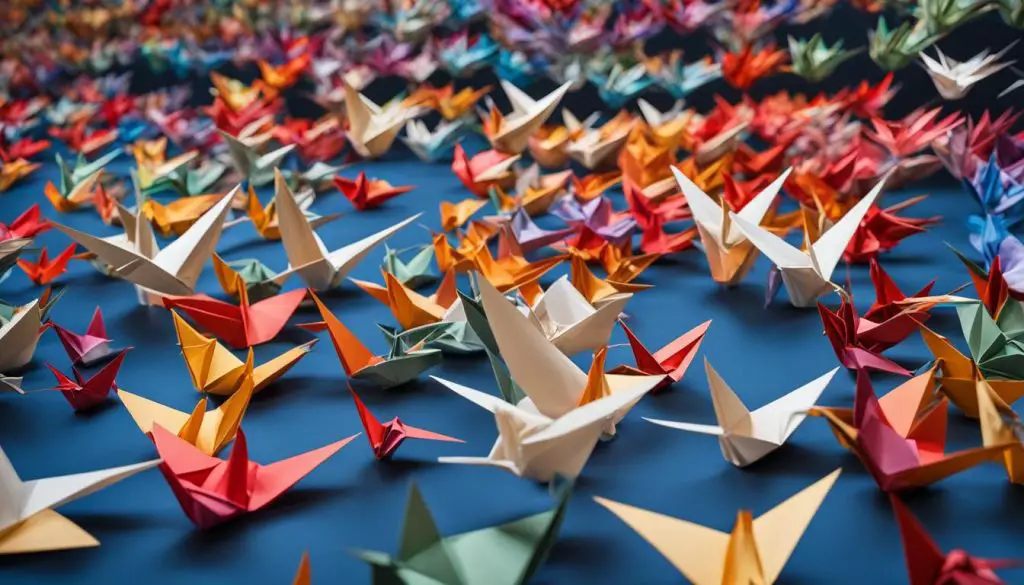
| Country | Origami Crane Symbolism |
|---|---|
| Japan | Good luck, longevity, and protection |
| China | Longevity and immortality |
| Korea | Wisdom, loyalty, and happiness |
| Western cultures | Decoration, gifts, and symbols of peace |
Origami Cranes as a Symbol of Peace in Hiroshima
In Hiroshima, the origami crane holds a special place as a symbol of peace and remembrance. The Hiroshima Peace Memorial Park, located near the epicenter of the atomic bomb blast, is adorned with thousands of paper cranes sent from around the world. This powerful display pays homage to Sadako Sasaki, a young girl whose story touched the hearts of many.
Sadako Sasaki was just two years old when the bomb fell on Hiroshima. Years later, she developed leukemia as a result of the radiation exposure. During her time in the hospital, Sadako folded hundreds of paper cranes with the hope of healing and peace. Although she tragically passed away at the age of 12, her legacy continues through the tradition of folding paper cranes.
The paper cranes sent to the Hiroshima Peace Memorial Park serve as a collective symbol of peace and a reminder of the devastating impact of war. Visitors from all over the world contribute to this poignant display, honoring Sadako’s wish for a peaceful world. As you walk among the cranes, you can’t help but feel the weight of history and the power of hope for a better future.
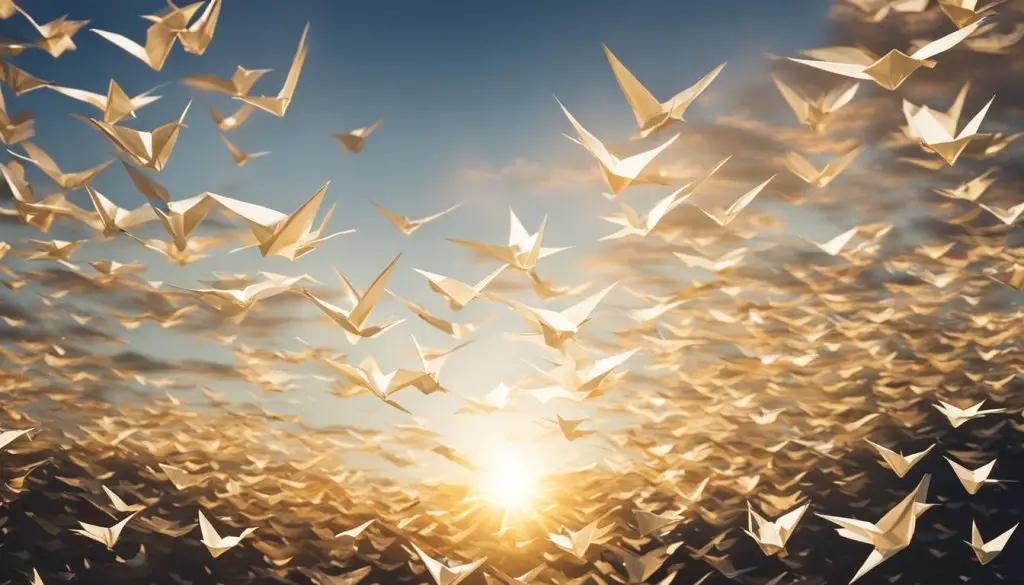
Conclusion
The tradition of making origami cranes holds deep cultural and symbolic significance. From their origins in Japan to their spread as a symbol of hope and peace, the paper crane has captured the hearts and minds of people around the world. Whether you fold origami cranes for luck, make a wish, or use them as a symbol of healing, this ancient art form brings joy and a sense of connection to a rich cultural tradition.
As you fold your own origami cranes, you become part of a legacy that spans centuries. The symbolism of these paper birds represents more than just luck; they embody hope and peace. The intricate folds and delicate nature of the crane remind us of the power of simplicity and the beauty that can be found in even the smallest acts. Each crane you fold is a testament to your creativity and ability to bring positivity into the world.
So, take a moment to appreciate the ancient art of origami and the symbolism it holds. As you fold each crane, let it serve as a reminder of the hope and peace that exists within you. May your journey with origami bring you luck, inspire you to spread kindness, and remind you of the universal human desire for a better world.
FAQ
Will making a thousand white crane origami figures bring you good luck?
Making a thousand origami cranes, known as senbazuru, is believed to bring luck and grant wishes. While there is no guarantee of good luck, folding the cranes can be a meaningful and meditative practice.
What is the history and significance of origami in Japan?
Origami has a long history in Japan, dating back to the 6th century. The crane, in particular, holds great significance in Japanese culture and symbolizes good fortune, longevity, and protection. The tradition of folding origami cranes began in feudal Japan, where they were exchanged as symbols of honor and loyalty.
Can you tell me the story of Sadako Sasaki and 1,000 paper cranes?
Sadako Sasaki was a young girl who developed leukemia as a result of radiation exposure from the Hiroshima atomic bomb. She believed that if she folded one thousand paper cranes, she would be granted a wish for good health. Her story spread, and her paper cranes became a symbol of hope and peace.
What is the symbolism and meaning of the origami crane?
The origami crane symbolizes good fortune, longevity, and protection. It is often referred to as the “bird of happiness” in Japan. Folding a thousand origami cranes is believed to bring luck and grant wishes. The wings of the crane are thought to provide protection, and there is a traditional prayer that asks for the heavenly cranes to cover and protect loved ones.
How has the spread of origami and crane symbolism occurred?
Origami has gained popularity worldwide and is now practiced as a form of art and leisure activity in many countries. The symbolism of the crane and the tradition of folding origami cranes for luck and peace have also spread beyond Japan. People from different cultures and backgrounds now fold paper cranes as a symbol of hope and healing.
What is the significance of origami cranes in Hiroshima?
In Hiroshima, the origami crane has a significant presence at the Hiroshima Peace Memorial Park. Thousands of paper cranes are sent to the park each year from all over the world and serve as a collective symbol of peace, healing, and remembrance.
Is folding origami cranes for good luck and fortune a common practice?
Folding origami cranes is believed to bring good luck and fortune. Many people engage in the practice of folding one thousand cranes, known as senbazuru, in order to make a wish or bring about a positive change in their lives. White origami cranes are especially considered to bring good luck and are often used in wedding ceremonies and other celebrations.
What is the conclusion about origami cranes and their symbolism?
The tradition of making origami cranes holds deep cultural and symbolic significance. Whether it is for luck, a wish, or as a symbol of healing, folding origami cranes continues to bring joy and a sense of connection to a rich cultural tradition.

